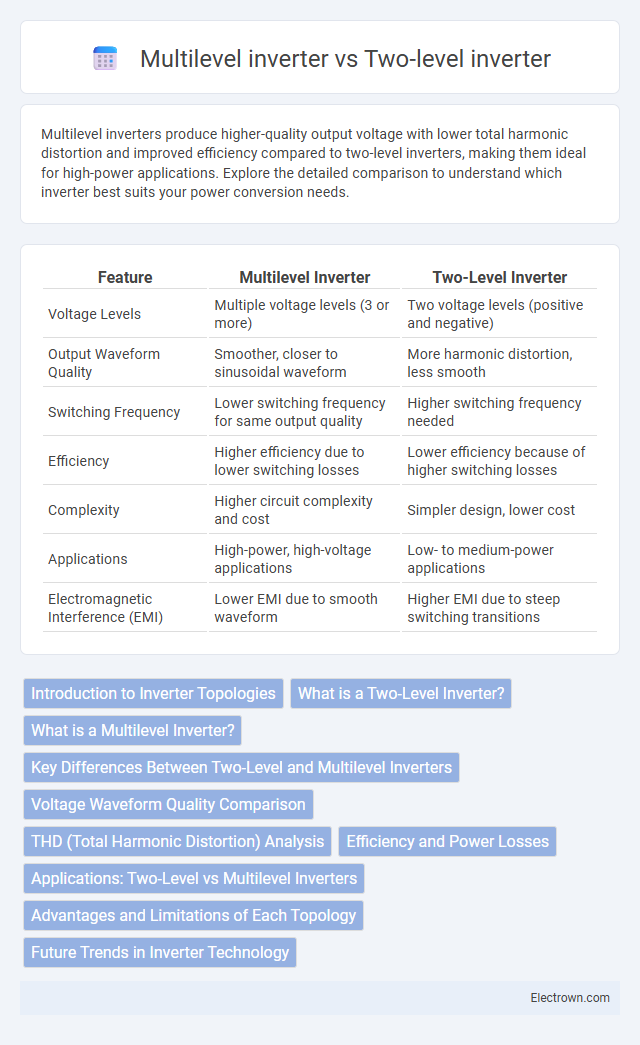Multilevel inverters produce higher-quality output voltage with lower total harmonic distortion and improved efficiency compared to two-level inverters, making them ideal for high-power applications. Explore the detailed comparison to understand which inverter best suits your power conversion needs.
Table of Comparison
| Feature | Multilevel Inverter | Two-Level Inverter |
|---|---|---|
| Voltage Levels | Multiple voltage levels (3 or more) | Two voltage levels (positive and negative) |
| Output Waveform Quality | Smoother, closer to sinusoidal waveform | More harmonic distortion, less smooth |
| Switching Frequency | Lower switching frequency for same output quality | Higher switching frequency needed |
| Efficiency | Higher efficiency due to lower switching losses | Lower efficiency because of higher switching losses |
| Complexity | Higher circuit complexity and cost | Simpler design, lower cost |
| Applications | High-power, high-voltage applications | Low- to medium-power applications |
| Electromagnetic Interference (EMI) | Lower EMI due to smooth waveform | Higher EMI due to steep switching transitions |
Introduction to Inverter Topologies
Multilevel inverters utilize multiple voltage levels from several DC sources to generate a staircase output waveform, significantly reducing harmonic distortion and improving power quality compared to two-level inverters. Two-level inverters switch between only two voltage states, producing a square waveform with higher harmonic content, often necessitating complex filtering. Multilevel inverter topologies such as diode-clamped, flying capacitor, and cascaded H-bridge provide scalable solutions for medium to high-voltage applications, enhancing efficiency and reliability.
What is a Two-Level Inverter?
A two-level inverter converts direct current (DC) into an alternating current (AC) voltage with two distinct output levels, typically +Vdc and -Vdc, producing a square wave output that approximates a sine wave. This inverter type is widely used in industrial motor drives and renewable energy systems due to its simpler design, lower cost, and ease of implementation. Compared to multilevel inverters, two-level inverters generate higher harmonic distortion and voltage stress, which can affect the performance and efficiency of power electronic applications.
What is a Multilevel Inverter?
A multilevel inverter is a power electronic device that converts DC voltage into AC voltage with multiple voltage levels, enhancing output waveform quality and reducing harmonic distortion compared to a conventional two-level inverter. Unlike the two-level inverter, which switches between only two voltage levels, multilevel inverters use several power semiconductor switches and capacitors to generate stepped voltages, improving efficiency and reducing electromagnetic interference. Your applications benefit from smoother voltage transitions and increased power quality, especially in high-voltage and medium-power systems.
Key Differences Between Two-Level and Multilevel Inverters
Two-level inverters convert DC to AC by switching between two voltage levels, while multilevel inverters produce output voltages with three or more levels, reducing harmonic distortion and improving waveform quality. Multilevel inverters offer higher power capacity, lower total harmonic distortion (THD), and enhanced efficiency compared to two-level inverters, which are simpler but generate higher voltage stress on components. Key differences include complexity, voltage handling capability, switching frequency, and suitability for high-power applications.
Voltage Waveform Quality Comparison
Multilevel inverters produce output voltage waveforms with significantly lower Total Harmonic Distortion (THD) compared to two-level inverters, resulting in smoother and closer-to-sinusoidal waveforms. This improvement in voltage waveform quality reduces electromagnetic interference and enhances the efficiency of power conversion in your applications. Multilevel inverters achieve this through multiple voltage levels, which effectively minimize voltage steps and harmonic content.
THD (Total Harmonic Distortion) Analysis
Multilevel inverters significantly reduce Total Harmonic Distortion (THD) compared to two-level inverters by producing output voltages with multiple steps, resulting in waveforms that more closely approximate a sine wave. Lower THD values in multilevel inverters improve power quality, minimize electromagnetic interference, and enhance the efficiency of electrical systems. Two-level inverters typically exhibit higher THD due to their limited switching states, generating more harmonic distortion and requiring extensive filtering.
Efficiency and Power Losses
Multilevel inverters exhibit higher efficiency and lower power losses compared to two-level inverters due to their ability to synthesize output voltages with reduced harmonic distortion and lower switching frequencies. The voltage stress on power devices in multilevel inverters is distributed across multiple levels, thereby decreasing switching losses and improving thermal performance. Two-level inverters typically experience higher switching losses and electromagnetic interference, limiting their efficiency in high-voltage and high-power applications.
Applications: Two-Level vs Multilevel Inverters
Two-level inverters are commonly used in low-power applications such as residential solar systems and small motor drives due to their simpler design and cost-effectiveness. Multilevel inverters are preferred in high-power industrial applications like medium-voltage motor drives, renewable energy plants, and grid-connected power converters because they offer improved output waveform quality, reduced harmonic distortion, and lower switching losses. Your choice between them depends on the power requirements and the need for efficiency and power quality in the specific application.
Advantages and Limitations of Each Topology
Multilevel inverters offer superior output voltage quality, reduced harmonic distortion, and lower electromagnetic interference compared to two-level inverters, making them ideal for high-power applications requiring efficient energy conversion. However, multilevel inverters come with increased complexity, higher component count, and greater control challenges, which can lead to elevated costs and maintenance efforts. Two-level inverters provide simplicity, cost-effectiveness, and ease of control for lower power systems, but they produce higher harmonic distortion and stress on power devices, limiting their efficiency in demanding industrial applications.
Future Trends in Inverter Technology
Multilevel inverters are leading future trends in inverter technology due to their enhanced efficiency, reduced harmonic distortion, and capability to handle higher voltage levels compared to two-level inverters. Advanced control algorithms and silicon carbide (SiC) devices are being integrated into multilevel inverter designs to improve power density and thermal management. Research is also focused on expanding their applications in renewable energy systems and electric vehicle drives, where high-performance and scalability are critical.
Multilevel inverter vs Two-level inverter Infographic

 electrown.com
electrown.com